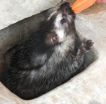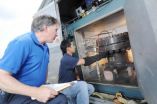(Press-News.org) Woe to the clueless predator trying to make a meal of the African crested rat, a rodent that applies poisonous plant toxin to sponge-like hairs on its flanks, a discovery recently made by Jonathan Kingdon and colleagues from the National Museums of Kenya, the Wildlife Conservation Society, and University of Oxford.
In the only known instance of a mammal acquiring a lethal toxin from a plant for defense, the researchers have discovered where the African crested rat (or maned rat) gets its poison: the Acokanthera tree, the same source used by East African hunters for poison arrows.
The study appears online in the Proceedings of The Royal Society B. The authors include: Jonathan Kingdon, Chris Holland, Tom Gheysens, Maxime Boulet-Audet, and Fritz Vollrath of the University of Oxford; Bernard Agwanda of the National Museums of Kenya; and Margaret Kinnaird and Tim O'Brien of the Wildlife Conservation Society.
"The African crested rat is a fascinating example of how a species can evolve a unique set of defenses in response to pressure from predators," said Dr. Tim O'Brien, Senior Scientist of the Wildlife Conservation Society and a co-author on the study. "The animal and its acquired toxicity is unique among placental mammals."
Scientists have long suspected that the African crested rat is poisonous, primarily due to the animal's specialized behavior, such as exposing a black-and-white coloration on its flanks when threatened by predators, and accounts of dogs becoming ill or dying after encounters with rats. The new discovery concerns the nature of the chemical defense. Instead of producing poison itself—as is the case with poisonous mammals such as the duck-billed platypus and solenodon—the African crested rat finds its toxin (called ouabain) in tree bark.
The researchers confirmed the hypothesis by presenting a wild-caught rat with branches and roots of the Acokanthera tree. The rodent proceeded to gnaw and masticate the bark (avoiding the leaves and fruit) and apply the "slaver" on its flanks. Further, the research team employed electron microscopes to examine the unique structure of the flank hairs. In doing so, they found that the perforated cylindrical structure of the hairs facilitates the rapid absorption of the poisonous saliva. Interestingly, ouabain has also been used by doctors for centuries as a clinical treatment against congestive heart failure.
Besides its warning coloration and poisonous hairs, the African crested rat possesses a thick reinforced skull, thick vertebrae, and unusually tough skin, all protection for the small rodent that rarely grows to more than 2 pounds in weight.
Several mysteries about the enigmatic rodent remain, including how the animal uses poison without succumbing to it.
INFORMATION:
African rodent uses 'poison arrow' toxin to deter predators
Wildlife Conservation Society, University of Oxford, and National Museums of Kenya investigate first known mammal to use plant poison in defense
2011-08-04
ELSE PRESS RELEASES FROM THIS DATE:
What's in a kids meal? Not happy news
2011-08-04
High-calorie, high-sodium choices were on the menu when parents purchased lunch for their children at a San Diego fast-food restaurant. Why? Because both children and adults liked the food and the convenience.
However, the study of data compiled by researchers in the Department of Pediatrics at the University of California, San Diego, appearing this week in the new journal, Childhood Obesity, showed that convenience resulted in lunchtime meals that accounted for between 36 and 51 percent of a child's daily caloric needs. In addition, 35 to 39 percent of calories came ...
First large study to find HIV epidemic among gays in the Middle East
2011-08-04
NEW YORK (Aug. 2, 2011) -- HIV epidemics are emerging in several countries in the Middle East and North Africa among men who have sex with men, a term that encompasses gay, non-gay identified homosexual men, and transgendered and bisexual men.
Though HIV infection levels were historically very low in the Middle East and North Africa, substantial levels of HIV transmission have been found, beginning in 2003, among men who have sex with men, a hidden and stigmatized population in this part of the world. These findings are published today in PLoS Medicine and represent the ...
Georgia Tech proposes Internet consumer nutrition label
2011-08-04
When it comes to broadband speeds, U.S. Internet service providers (ISPs) largely deliver on their promises, says a report issued today by the Federal Communications Commission, but "throughput" is only one of several metrics listed in the report that affect network performance. ISPs should provide a broadband "nutrition label"—easy-to-understand information about service-limiting factors—and users need better ways of measuring the performance their ISPs are delivering, concludes a study from the Georgia Tech College of Computing.
Out of some 2 billion Internet users ...
BGU researchers develop webcam tool to improve office worker posture
2011-08-04
BEER-SHEVA, ISRAEL, August 2, 2011– A multidisciplinary team at Ben-Gurion University of the Negev has developed a new training method using a desktop webcam to improve ergonomic posture and reduce the risk of musculoskeletal disorders (MSD) among office workers using computers.
According to an article in Applied Ergonomics in the forthcoming issue, a group of 60 workers received both office training and an automatic frequent-feedback system that displayed a webcam photo of a worker's current sitting posture alongside the correct posture photo taken during office training. ...
Plant biologists dissect genetic mechanism enabling plants to overcome environmental challenge
2011-08-04
Cold Spring Harbor, NY -- When an animal gets too hot or too cold, or feels pangs of hunger or thirst, it tends to relocate – to where it's cooler or hotter, or to the nearest place where food or water can be found. But what about vegetative life? What can a plant do under similar circumstances?
Plants can't change the climate and they can't uproot themselves to move to a more favorable spot. Yet they do respond successfully to changes in environmental conditions in diverse ways, many of which involve modifications of the way they grow and develop.
Plant biologists ...
August 2011 GSA Today science: Understanding Earth's eroding surface with 10Be
2011-08-04
Boulder, Colorado, USA - The August GSA TODAY science article is now online at http://www.geosociety.org/gsatoday/archive/21/8/.
The modification of Earth's surface by erosion is one of the most important geological processes in terms of its impact on society, as well as its influence on the geological record, but geologists have been lacking a well-determined compilation of pre-human rates of erosion. In a groundbreaking compilation of 1528 calculations of surface erosion rates from 80 study areas from all over the world, authors Eric Portenga and Paul Bierman of the ...
Stray-bullet shootings most often harm women and individuals at low-risk for violence
2011-08-04
(SACRAMENTO, Calif.) — In the first nationwide study of stray-bullet shootings, Garen Wintemute, professor of emergency medicine and director of the Violence Prevention Research Program at UC Davis School of Medicine and Medical Center, quantifies mortality and injury among victims of these unexpected events. His research is published as a letter in the August 3 issue of the Journal of the American Medical Association.
"Stray-bullet shootings create fear and insecurity in many communities," said Wintemute. "People stay indoors, don't let their children play outside, and ...
Atmospheric simulations will help NASA interpret data from the Juno Mission to Jupiter
2011-08-04
In August of 2016, when NASA's Juno Mission begins sending back information about the atmosphere of the planet Jupiter, research done by Georgia Institute of Technology engineers using a 2,400-pound pressure vessel will help scientists understand what the data means. The Juno probe is scheduled to be launched August 5 from Cape Canaveral Air Force Station in Florida.
Because Jupiter has been largely unchanged since its formation at the birth of our solar system, scientists hope Juno will resolve unanswered questions not only about the massive planet, but also about how ...
Scientists identify what makes us feel 'bad' when we're sick, how to treat it
2011-08-04
PORTLAND, Ore. — A signaling system in the brain previously shown to regulate sleep is also responsible for inducing lethargy during illness, according to research conducted at Oregon Health & Science University Doernbecher Children's Hospital.
This research is particularly meaningful because it implies that a new class of drugs developed to treat sleep disorders can reverse the inactivity and exhaustion brought on by acute illness. Although the sleep drugs were initially designed to treat narcolepsy, they have the potential to restore energy and motivation in patients ...
IT solution to improve hospital workflow and schedules
2011-08-04
A new customised IT business management system developed by Queensland University of Technology (QUT) researchers and capable of improving the scheduling of resources and workflow in surgical theatres has been successfully demonstrated in a German hospital.
Dr Chun Ouyang, from QUT's Business Process Management (BPM) group, said the system was built based on an automated workflow system known as YAWL, and allowed hospitals to more efficiently manage the co-ordination of expensive surgery-related resources.
The project is being undertaken in partnership with German ...
LAST 30 PRESS RELEASES:
Norbert Holtkamp appointed director of Fermi National Accelerator Laboratory
New agentic AI platform accelerates advanced optics design
Biologists discover neurons use physical signals — not electricity — to stabilize communication
Researchers discover that a hormone can access the brain by hitchhiking
University of Oklahoma researcher awarded funding to pursue AI-powered material design
Exploring how the visual system recovers following injury
Support for parents with infants at pediatric check-ups leads to better reading and math skills in elementary school
Kids’ behavioral health is a growing share of family health costs
Day & night: Cancer disrupts the brain’s natural rhythm
COVID-19 vaccination significantly reduces risk to pregnant women and baby
The role of vaccination in maternal and perinatal outcomes associated with COVID-19 in pregnancy
Mayo Clinic smartwatch system helps parents shorten and defuse children's severe tantrums early
Behavioral health spending spikes to 40% of all children’s health expenditures, nearly doubling in a decade
Digital cognitive behavioral treatment for generalized anxiety disorder
Expenditures for pediatric behavioral health care over time and estimated family financial burden
Air conditioning in nursing homes and mortality during extreme heat
The Alps to lose a record number of glaciers in the next decade
What makes a good proton conductor?
New science reporting guide published for journalists in Bulgaria
New international study reveals major survival gaps among children with cancer
New science reporting guide published for journalists in Turkey
Scientists develop a smarter mRNA therapy that knows which cells to target
Neuroanatomy-informed brain–machine hybrid intelligence for robust acoustic target detection
Eight SwRI hydrogen projects funded by ENERGYWERX
The Lundquist Institute and its start-up company Vitalex Biosciences Announces Strategic Advancement of Second-Generation fungal Vaccine VXV-01 through Phase 1 Trials under $40 Million Competitive Con
Fine particles in pollution are associated with early signs of autoimmune disease
Review article | Towards a Global Ground-Based Earth Observatory (GGBEO): Leveraging existing systems and networks
Penn and UMich create world’s smallest programmable, autonomous robots
Cleveland researchers launch first major study to address ‘hidden performance killer’ in athletes
To connect across politics, try saying what you oppose
[Press-News.org] African rodent uses 'poison arrow' toxin to deter predatorsWildlife Conservation Society, University of Oxford, and National Museums of Kenya investigate first known mammal to use plant poison in defense

